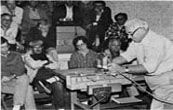|
|
Finishing Lessons from a Small Shop
Professional
by Chris Black
If you
ask any woodworker what their weakest skill set is, they will
probably say finishing. Perhaps it's because we've spent all our
time mastering joinery and furniture design that we've neglected the
art of finishing. As a result, we relegate ourselves to finishing
with something someone recommended at a paint store that may or may
not be applicable to what we're doing. Then when that doesn't work
out, we fall back on slow-drying, slow-building wiping oil that at
least gave us predictable results in the past. Start talking about
coloring wood and we're completely lost. We'll try any old can of
thin hardware store stain and pray for the best. How come we'll
spend days on design and weeks on construction but give little
consideration to the coloring process?
In my years as a small
commercial shop owner, I've learned some valuable lessons about
finishing, mostly through trial and error and well, disaster. When
coloring a hard, close-pored wood like maple, try using dyes instead
of pigment stains. We've all tried that can of off-the-shelf stain.
We wipe it on. We wipe it off, and most of it comes off. What
doesn't come off, blotches and splotches. The problem with pigment
stain is that the pigment particles are too large. Without large,
open, oak-sized wood pores to get lodged in, the pigment has no
place to go. It never builds color or worse, it covers unevenly.
Dyes, on the other hand, use color that is completely dissolved in
its carrier. Therefore, dyes color closed-pored hardwoods much more
evenly and with much greater control than pigment
stains.
When coloring raw wood with water-based dyes, sand
the piece with up to 220 grit sandpaper. Next, take a damp sponge
and go over the portion to be dyed in order to raise the wood's
grain. After the water dries, sand off the fuzzy fibers with 220
grit sandpaper. Now, wet the piece again with the sponge and
immediately apply the dye in any manner you like. I generally rag it
on. The water from the sponge acts as a wood conditioner and
guarantees a uniform appearance with little chance of splotching.
Try it, you'll be amazed.
To short-cut the procedure, put the
dye down with a grey
Scotch-Brite Hand
Pad
(196202) going with the grain. The abrasive pad will
cut down the grain as it rises from the moisture in the dye, and you
won't have to sponge and sand.
How about knotty softwoods
like pines, spruces and firs? You can employ the same techniques
listed before with good results, but for great results try this:
First, seal the surface of the wood with a 1 lb. to 1½ lb. cut of
blonde dewaxed
shellac
(195863), paying particular attention to the areas
around knots and endgrain. Once the shellac is dry, usually within a
couple of minutes, lightly sand with 600 grit (CAMI) sandpaper.
Apply another coat of shellac. Now, add any color of
Transtint Concentrated Wood
Dye
directly into the liquid shellac. After stirring the
dye/shellac mixture, brush or pad it on to color the wood. Start
with about 10 or 15 drops of dye per 8 oz. cup of liquid shellac and
test to see if you're pleased with the results. Because the color is
completely sealed from the wood, there's no chance of splotching.
Since you control the amount of dye added to the shellac, you
readily get the depth of color you want. At this point, you can
topcoat with just about any finish since most finishes are
compatible with dewaxed shellac.
Speaking of shellac, it has
become my go-to finish for everything I once finished with oil or
nitrocellulose lacquer. For years the wood coating industry has
maligned shellac as a weak, outdated and difficult to use finish.
Some of this bad press may come from the fact that most shellac
comes premixed in a can with relatively high wax content. Canned
shellac usually ships as a 3 lb. cut which is too thick to apply
easily. Zinsser now makes a premixed
2 lb. cut shellac
(195831) which is quite good. But the key to
getting the best results from shellac is to buy it dry in
dewaxed flakes
(195863), and only mix what you're going to use within a week or
two. By combining your flakes with denatured alcohol in a blender,
you avoid the 24-hour waiting period before the flakes
dissolve.
As for hand application, I've found two methods
that work well with shellac. Again, this presumes you've thinned the
shellac to a 1½ lb. cut (1½ lbs. of shellac flakes to 1 gallon of
alcohol or any reduced proportion). The first method is to pad the
shellac on. Those familiar with French polishing will recognize this
technique. Just wad up any absorbent cloth the size of a computer
mouse and wrap it in a tight woven material like an old dress shirt.
Squirt some shellac onto the pad and wipe it on. If the pad starts
to drag a bit, put a drop of
Camellia Oil
(056460) in the center of the pad and be sure to let each
coat dry for 30 seconds or so before laying on another
coat.
The second technique involves a small, natural bristle,
artist's fan brush. You can find them at art supply stores. By
dipping the fan brush in the shellac and quickly whisking it onto
the wood, you can effectively spread shellac where a bulbous pad
wouldn't fit.
Another much-abused finish I've come to rely on
is waterborne polyurethane, such as
Gloss Ceramithane
(195234). It's tough, dries quickly and it colors easily
with
Transtint Wood Dyes
and
Universal Tinting Colors
(UTCs). Waterborne finishes are also easy to apply if you
know how. When you brush or roll the stuff you get bubbles, craters
and foaming, anything but a smooth finish. So why not rag it on? We
apply everything else by wiping, so why not water-based topcoats? To
really supercharge the event add just a little distilled water (no
more than 5% by volume) to the sauce to thin it. Distilled water
doesn't have minerals in it that can contaminate the finish and
cause discoloration. By wiping on the finish you assure thin coats
which dry quickly and keep dust nibs down. You can usually recoat in
as little as 15-20 minutes.
What about those dust nibs? Most
small shops don't have the luxury of a dust-free finishing room. In
fact, most of us finish outside where bugs, pollen and other perils
invade our films. Fast-drying finishes like shellac and waterborne
polyurethane will help but you may have to consider finishing the
finish. Yes, rubbing out. Look, it's not that complicated and
besides, it is nearly impossible to get a perfect film straight from
the can.
Step one is easy - let the finish fully cure before
you start rubbing it out. Wait 24 hours for shellac and 2-5 days for
water-based polyurethane, depending on the weather. Once the finish
is cured, you will need to flatten it with 600 grit (CAMI) or P1200
grit (FEPA) sandpaper to get a uniform sheen or scratch pattern.
Make sure you lubricate the paper with soapy water or mineral
spirits to avoid cutting through the finish. Always sand with the
wood grain, and stop frequently to check your progress. If your goal
is a flat or matte finish, just wax and buff. You're done. The paste
wax (00212 Staples paste wax) will fill the tiny scratches left
behind by the sandpaper and give you a low luster finish much like
one or two coats of oil. To achieve a satin/semi-gloss finish, skip
the wax and rub
Meguiar's Fine-Cut Cleaner
(195895) on the finish with a clean,
lint free cloth
(195993). Make sure you buff with the grain. If you want a glossy
finish, use
Meguiar's Swirl Remover
(195896). Each time you switch rubbing compounds, it is
important to use a clean rag so you don't cross-contaminate the
different levels of abrasive. Working with the grain will help
minimize the appearance of fine scratches. Also, these materials cut
fast, so there's no need for buffing machines or circular
motions.
Finally, if you're going for a super glossy,
wet-look shine, then
Meguiar's Show Car Glaze
(195897) will polish out any blemishes left behind.
Remember, you can stop and wax anywhere along the process if you're
happy with the level of sheen. Also, don't skip a step - you'll only
make a mess and wonder why you're not getting
anywhere.
|
|



